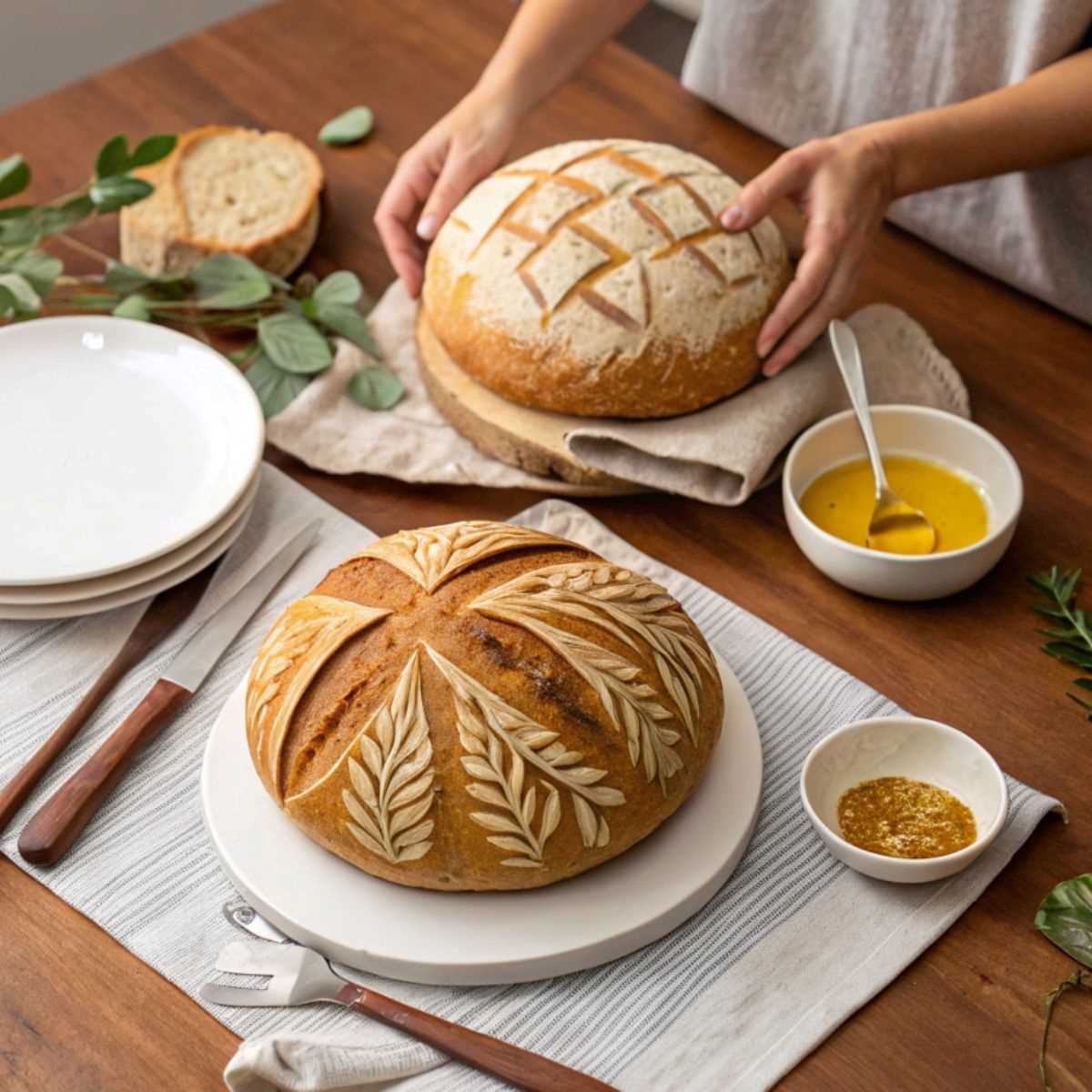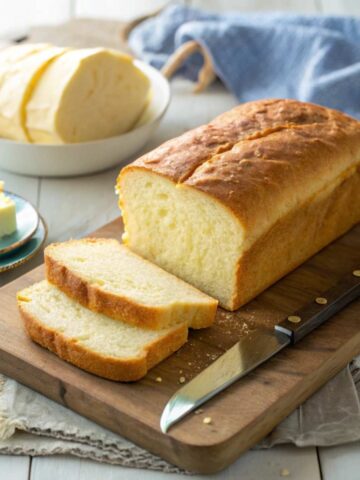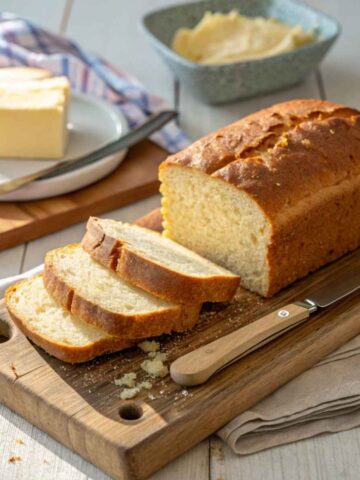Sourdough bread has a rich, centuries-old tradition and is beloved for its unique taste and health benefits. The long fermentation process used to make sourdough helps develop its signature tangy flavor and gives it a more complex texture than regular bread. But for those on a gluten-free diet: Is sourdough bread gluten free? This guide will examine whether sourdough is safe for those avoiding gluten and how you can enjoy gluten-free versions of this iconic bread.

Jump to:
- What is Gluten?
- What Makes Sourdough Bread Different?
- Is Regular Sourdough Bread Gluten-Free?
- How Fermentation Affects Gluten in Sourdough
- Can People with Gluten Sensitivity Eat Sourdough?
- Is There a Gluten-Free Version of Sourdough Bread?
- How to Make Gluten Free Sourdough Bread
- Gluten-Free Sourdough Starter
- Key Ingredients for Gluten Free Sourdough Bread
- How to Achieve the Perfect Gluten-Free Sourdough Texture
- Health Benefits of Gluten Free Sourdough Bread
- Common Challenges When Making Gluten Free Sourdough Bread
- Storing and Freezing Gluten Free Sourdough Bread
- Frequently Asked Questions
- Gluten-Free Sourdough Bread Recipe
What is Gluten?
Definition of Gluten
Gluten is a protein primarily present in wheat, barley, and rye. It gives dough its elasticity and helps bread rise and maintain its shape. While gluten is perfectly safe for most people to consume, it can cause serious problems for those with certain health conditions.
Why People Avoid Gluten
People with celiac disease, non-celiac gluten sensitivity, or a wheat allergy must avoid gluten. In people with celiac disease, gluten triggers an immune response that damages the small intestine, leading to malabsorption of nutrients and other health complications. Even small traces of gluten can cause harm, so avoiding it is essential for managing symptoms and long-term health.
What Makes Sourdough Bread Different?
The Fermentation Process in Sourdough
Sourdough bread is made through natural fermentation, using wild yeast and bacteria to leaven the dough. Unlike traditional bread, which relies on commercial yeast, sourdough starter—flour and water—can ferment over several days. This slow fermentation develops the bread’s flavor and gives it a tangy taste.
How Sourdough Differs from Regular Bread
The primary difference between sourdough and other types of bread lies in the fermentation process. While both types of bread contain gluten (if made with wheat flour), the long fermentation in sourdough can break down some gluten proteins, making it easier for some people to digest.
Is Regular Sourdough Bread Gluten-Free?
Why Traditional Sourdough is Not Gluten-Free
Despite its unique fermentation process, regular sourdough bread made from wheat flour or other gluten-containing grains is not gluten-free. The fermentation may reduce the amount of gluten but does not eliminate it. As a result, traditional sourdough bread is still unsafe for people with celiac disease or severe gluten sensitivity.
The Myth of Sourdough Being Safe for Gluten-Sensitive People
There’s a common myth that sourdough bread is safe for people with gluten sensitivity because the fermentation process “destroys” the gluten. While fermentation breaks down some gluten, enough remains that people with gluten-related disorders should avoid regular sourdough bread.
How Fermentation Affects Gluten in Sourdough
The Role of Fermentation in Reducing Gluten Content
During fermentation, the sourdough starter's wild yeast and bacteria break down some gluten proteins in the dough. This makes the gluten easier to digest for some people and is one reason why sourdough bread is considered more “gut-friendly” compared to other types of bread.
Why Fermentation Doesn’t Eliminate Gluten Entirely
While fermentation reduces the gluten content, it doesn’t obliterate it. Studies show that traditional sourdough bread made with wheat flour still contains enough gluten to cause a reaction in individuals with celiac disease or severe gluten sensitivity. Therefore, it’s not considered safe for those avoiding gluten.
Can People with Gluten Sensitivity Eat Sourdough?
The Difference Between Celiac Disease and Gluten Sensitivity
It’s important to distinguish between celiac disease and non-celiac gluten sensitivity. People with celiac disease must strictly avoid all gluten, as even trace amounts can cause damage to their intestines. In contrast, those with gluten sensitivity may tolerate small amounts of gluten without serious long-term effects, though it may still cause discomfort.
Why Gluten-Sensitive People Might Tolerate Sourdough
Some individuals with gluten sensitivity (but not celiac disease) may find that they can tolerate small amounts of sourdough bread because the fermentation process partially breaks down the gluten. However, this varies from person to person, and it’s always best to consult a healthcare professional before introducing gluten-containing foods into your diet.
Is There a Gluten-Free Version of Sourdough Bread?
The good news is that gluten free sourdough bread exists! It’s made using gluten-free flour like rice flour, sorghum flour, and other grains that don’t contain gluten. These breads undergo the same fermentation process as traditional sourdough without gluten risk.
Gluten Free Sourdough Bread Options

Many bakeries and home bakers have developed recipes for gluten free sourdough bread, allowing people with celiac disease and gluten sensitivity to enjoy this delicious bread without worrying about gluten exposure.
Key Ingredients in Gluten-Free Sourdough
Gluten free sourdough bread is typically made with a combination of gluten-free flours, such as:
- Brown rice flour
- Sorghum flour
- Tapioca starch
- Potato starch: These flours mimic the texture and flavor of traditional sourdough without the gluten.
How to Make Gluten Free Sourdough Bread

Making gluten free sourdough bread at home may seem daunting, but it’s surprisingly simple once you get the hang of it. Here’s a step-by-step guide to get you started.
A Complete Guide to Crafting Your Own Gluten-Free Sourdough Starter
- Mix 1/4 cup of gluten-free flour (brown rice flour) in a clean jar with 1/4 cup of water.
- Stir until combined, and leave the jar uncovered for 24 hours.
- "feed" your starter each day with an additional 1/4 cup of gluten-free flour and water. Stir and leave uncovered.
- After 5-7 days, your starter will be bubbly, active, and ready to use. It should also have a slightly tangy smell, which indicates it’s fermenting correctly.
- Keep feeding your starter regularly. When you’re ready to bake, use about half of it for your bread recipe and continue feeding the remaining starter to keep it alive for future baking.
Critical Tips for Baking Gluten Free Sourdough Bread
- Use a combination of flours: For a well-textured gluten-free sourdough, mix several gluten-free flours, such as rice, sorghum, and tapioca. This creates a balanced texture that’s chewy and light.
- Let it rise longer: Gluten-free doughs often need more time to rise than traditional dough, so be patient and let it rise until it is doubled in size.
- Use a Dutch oven: Baking gluten-free sourdough in a Dutch oven helps trap steam, giving you a crisp crust while maintaining a soft interior.
Gluten-Free Sourdough Starter
A gluten-free sourdough starter is the foundation of any gluten free sourdough bread recipe. It functions similarly to a traditional starter but uses gluten-free flour like rice, sorghum, or buckwheat.
How to Make and Maintain a Gluten-Free Sourdough Starter
Maintaining a gluten-free starter is similar to a regular starter:
- Feed it regularly (usually daily or every other day) with gluten-free flour and water.
- If you don't use it frequently, store it in the fridge, and feed it once a week to keep it alive.
The Best Gluten-Free Flours for Sourdough
Here are some of the best gluten-free flours to use for your sourdough starter and bread:
- Brown rice flour: Provides a mild flavor and good structure.
- Sorghum flour: Adds a hearty, whole-grain flavor.
- Tapioca starch: Helps bind the dough and creates a chewy texture.
Key Ingredients for Gluten Free Sourdough Bread
To achieve the best gluten free sourdough bread, using the right combination of ingredients is essential. Here’s what you’ll need:
Best Gluten-Free Flours for Sourdough
- Rice flour is a staple in gluten-free baking, giving the bread structure.
- Sorghum flour: Provides a nutty flavor and adds to the bread’s chewiness.
- Tapioca starch: Adds elasticity and helps the bread rise.
- Psyllium husk: This is an excellent binding agent that improves the texture and helps hold moisture in the dough.
Additional Ingredients Like Psyllium Husk and Xanthan Gum
- Psyllium husk: Helps mimic the gluten's elasticity and gives the dough structure.
- Xanthan gum: Adds elasticity and helps hold the bread together during baking, ensuring it doesn’t crumble.
How to Achieve the Perfect Gluten-Free Sourdough Texture
Getting the perfect sourdough texture can be tricky, especially when gluten-free. Here are some tips to ensure your bread comes out with a chewy crumb and crispy crust:
Tips for a Chewy, Crusty Gluten-Free Sourdough Loaf
- Use a Dutch oven: This helps the bread steam while baking, creating a crisp, golden crust.
- Bake at a high temperature: Baking at 450°F (232°C) will help give you a good crust without drying out the bread.
How to Ensure Your Bread Rises Properly
- Allow enough time to rise: Gluten-free doughs often need more time because they don’t have the same elasticity as wheat-based doughs.
- Check for doneness: When your bread is ready, it will have a golden crust and sound hollow when tapped on the bottom.
Health Benefits of Gluten Free Sourdough Bread
Nutritional Benefits of Sourdough Fermentation
The fermentation in sourdough breaks down complex carbs, making them easier on the digestive system. This makes sourdough, including gluten-free varieties, a better option for people with sensitive stomachs.
How Gluten-Free Sourdough Differs in Nutrition from Regular Bread
While traditional sourdough is rich in nutrients, gluten-free sourdough can also be packed with fiber, vitamins, and minerals, depending on the flour used. For example, brown rice flour and sorghum flour provide reasonable amounts of B vitamins and fiber.
Common Challenges When Making Gluten Free Sourdough Bread
Why Gluten-Free Sourdough Can Be Tricky
Because gluten-free flours lack the elasticity of wheat flour, gluten-free sourdough dough can be challenging to work with. It’s often stickier and less stable, requiring specific techniques to ensure success.
Solutions to Common Problems (Crumbly Texture, Poor Rise)
- Add psyllium husk or xanthan gum to improve the bread’s structure for crumbly texture for crumbly texture.
- For poor rise: Allow the dough more time to proof in a warm, draft-free area.
Storing and Freezing Gluten Free Sourdough Bread
How to Store Homemade Gluten-Free Sourdough
Keep your sourdough bread wrapped in a clean kitchen towel at room temperature for 1-2 days. Avoid storing in plastic, as it can trap moisture, leading to a soggy crust.
Best Practices for Freezing Sourdough Bread
Pre-slice the bread before freezing, and keep it in a freezer-safe bag for best results. To reheat, thaw at room temperature and then pop the slices in the oven for a few minutes to refresh the texture.
While traditional sourdough bread made from wheat flour is not gluten-free, the good news is that gluten free sourdough bread exists. It can be just as delicious as the original with the right ingredients and techniques. By making your gluten-free sourdough starter and experimenting with gluten-free flour, you can enjoy sourdough bread's tangy taste and chewy texture without the gluten. Whether you’re gluten-sensitive or have celiac disease, gluten-free sourdough is worth trying
Frequently Asked Questions
Traditional sourdough bread made with wheat flour is not safe for those with celiac disease. However, gluten free sourdough bread made with gluten-free flour is a great alternative.
Gluten-free sourdough uses alternative flours like rice, sorghum, and tapioca starch instead of wheat. It still undergoes the same fermentation process, resulting in a tangy, flavorful bread without gluten.
No, fermentation reduces but does not eliminate gluten. Traditional sourdough bread made with wheat flour is still unsafe for people with celiac disease or gluten sensitivity.
Look for gluten-free certifications on store-bought products. If you’re making sourdough at home, ensure all your ingredients are gluten-free, and your kitchen is cross-contamination-free.
Brown rice flour, sorghum flour, and tapioca starch are the best gluten-free flour for sourdough bread. Combining these flours with psyllium husk or xanthan gum helps create the best texture.

Gluten-Free Sourdough Bread Recipe
- Total Time: 7 hours 55 minutes
- Yield: 1 loaf 1x
Description
This gluten-free sourdough bread is tangy and chewy, perfect for gluten-free people.Made with a homemade gluten-free starter and a combination of gluten-free flour, it has all the flavor of traditional sourdough without gluten.
Ingredients
- 1 cup gluten-free sourdough starter (active and bubbly)
- 2 cups brown rice flour
- 1/2 cup sorghum flour
- 1/2 cup tapioca starch
- 2 teaspoon psyllium husk
- 1 teaspoon salt
- 1 1/2 cups water (lukewarm)
Instructions
- Mix the gluten-free sourdough starter, brown rice flour, sorghum flour, tapioca starch, psyllium husk, and salt in a large bowl.
- Add the lukewarm water gradually and stir until a sticky dough forms.
- Cover the bowl with a kitchen towel and let the dough rise in a warm place for 6-8 hours or until doubled in size.
- Preheat your oven to 450°F (232°C) and place a Dutch oven inside to heat.
- Shape the dough into a round loaf and transfer it to a sheet of parchment paper.
- Place the dough (on the parchment paper) into the preheated Dutch oven, cover, and bake for 30 minutes.
- Remove the lid and bake for 10-15 minutes until the crust is golden and crispy.
- Let the bread cool completely before slicing.
- Prep Time: 10 minutes
- Cook Time: 45 minutes
- Category: Bread
- Cuisine: gluten-free, Sourdough
Nutrition
- Calories: 180
Keywords: Gluten-Free Bread, Gluten-Free Sourdough, homemade sourdough





Leave a Reply